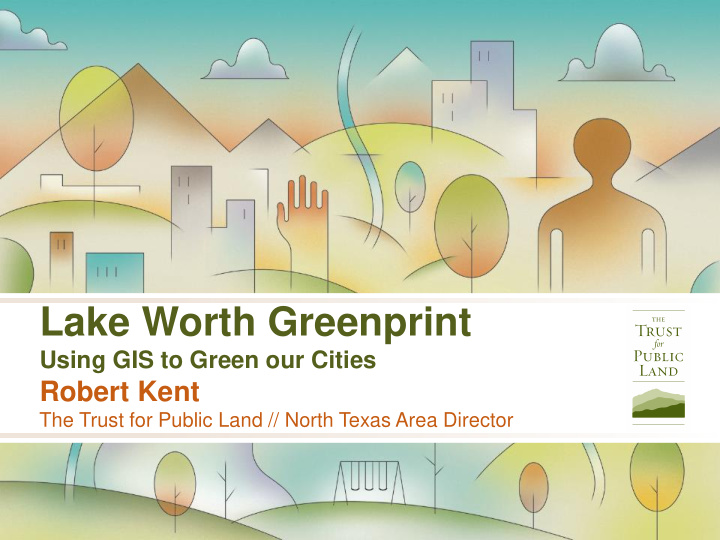



Lake Worth Greenprint Using GIS to Green our Cities Robert Kent The Trust for Public Land // North Texas Area Director
The Trust for Public Land —Conserving land for people
What is The Trust for Public Land? Founded in 1972, The Trust for Public Land is the leading nonprofit working to conserve land for people. We protect the places people care about and create close-to-home parks—particularly in and near cities, where 80 percent of Americans live.
What is The Trust for Public Land? Operating from more than 30 offices nationwide, we’ve protected more than 3 million acres from the inner city to the wilderness.
What is The Trust for Public Land? Nearly ten million people live within a ten-minute walk of a Trust for Public Land park, garden, or natural area, and millions more walk on our work every year.
Our Services Conservation Vision and GIS Conservation Finance SERVICES Conservation Transactions Park Design and Developm ent Research and Education
Conservation Vision How TPL Uses GIS to Green our Cities
Conservation Vision and GIS We provide the tools communities need to identify the most important land for conservation—and create and carry out a plan to protect it.
What is Geographic Information System (GIS)? • All of us use GIS every single day, whether we know it or not • GIS is a data platform designed to store, analyze, and present location-specific data • You all have a GIS app on your smartphone
What is Geographic Information System (GIS)? • But GIS is about more than navigating from point A to B • GIS can tell us things like: • Who owns land parcels • Percentage canopy cover • Poverty rate in an area • Prevalence of asthma • …and more
Lake Worth Greenprint
How does it work? • Uses a GIS-based analysis to help communities prioritize there parks and recreation goals • Is a collaborative process that proactively engages with the local community • Provides long-term vision and a concrete plan to protect the places most important to the community
Lake Worth Greenprint • 60,211-acre study area of the entire Lake Worth Watershed (excluding Eagle Mountain Lake) • Partnered with the City of Fort Worth , the Lake Worth Regional Coordination Committee , and the North Central Texas Council of Governments • Focused the Greenprint on water quality protection and recreation enhancement
Lake Worth Greenprint • Utilized GIS analysis, public polling, interviews, and stakeholder group • Identified lands that have maximum impact on water quality and recreational opportunities
Lake Worth Greenprint Action Plan 1. Raise funds to support action plan steps 2. Start a voluntary open space preservation program 3. Gather more information to understand and address water quality problems 4. Develop or enhance local government program/activities 5. Promote education and publicity 6. Create landowner incentives 7. Undertake additional planning and evaluation 8. Regulate for improved water quality outcomes
The Trust for Public Land —Land for people
Thank you! Robert Kent robert.kent@tpl.org
Recommend
More recommend